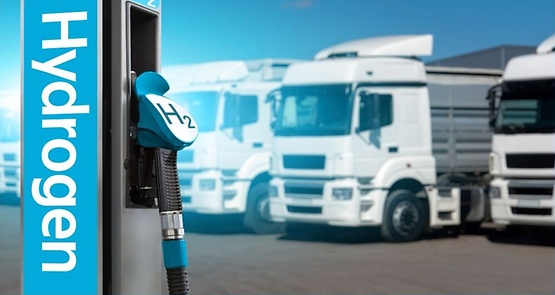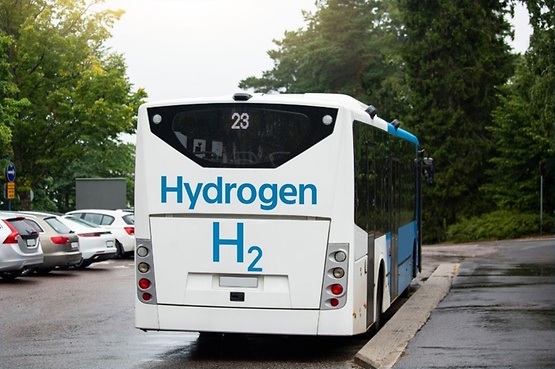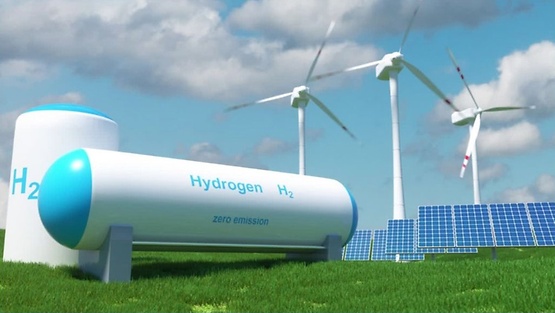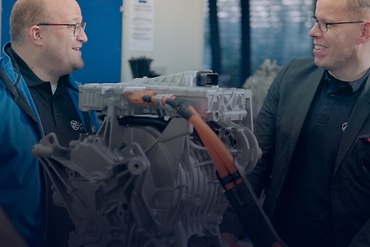
Contributed by Pedro Barata
May 14, 2024
5 minutes read
How hydrogen works – the fuel cell principle
Hydrogen: The road transport fuel of the future?
Hydrogen fuel cells are increasingly being talked about as the fuel of the future for heavy-duty vehicles. I want to give a quick overview on how it works and why it's part of the future of road transport.
When we talk about hydrogen as a fuel, we are talking about a chemical reaction using hydrogen to produce energy very quickly – energy that will power a fuel cell. Environmental concerns have been driving this technology forward for some years now, because it produces no polluting emissions or greenhouse gases (CO₂) when in operation.

The principle of the fuel cell is not new, however. It was discovered by the German Christian Schönbein in 1839 and developed by the Englishman William R. Grove in the following years. It is based on a simple chemical reaction: Hydrogen + Oxygen produces electricity + water + heat.
Hydrogen is stored under pressure in a special tank in the vehicle. This gas (H₂), combined with oxygen (O₂) from the ambient air, powers the fuel cell. The two gases react electrochemically inside the battery. This reaction produces electricity to power the vehicle's electric motor(s), while releasing only heat and water vapour (H₂O) through the "exhaust" pipe.

Hydrogen, a more than credible competitor to diesel fuel for heavy goods vehicles
Commercial vehicles travel long distances with their goods, so they need a very long range and a very high payload.
Hydrogen offers a long range, and refuelling takes just a few minutes, thanks to pumps capable of rapidly injecting pressurized hydrogen into the tank. Another advantage is the absence of a heavy battery, which drastically reduces the payload - for example, to propel a 38 tons CV, it would need a 14 tons battery!
Numerous hydrogen vehicle projects
Europe's leading CV manufacturers are already working on a number of pioneering projects. Volvo recently announced that, by 2025, its trucks would be running on hydrogen, with a range of up to 1,000 km and a refuelling time of less than 15 minutes.
In the public transport sector, the French national railway company SNCF has ordered twelve TER trains, due to go into commercial service at the end of 2025. Dozens of hydrogen-powered buses will be launched in the next months.
Hype, which was launched in Paris in 2015 to coincide with COP21, is developing and operating the first integrated hydrogen mobility platform for production, distribution and use. Taxis are the first market to be targeted, and thanks to a recent round of funding, Hype hopes to deploy 10,000 hydrogen taxis by 2024.

The limits of hydrogen: production and networking
Currently, the majority of the hydrogen consumed in Europe is produced from methane (known as "grey" hydrogen), which is a fossil fuel. This is a paradox when you consider that the aim of "hydrogen" electric vehicles is to reduce our carbon footprint and our dependence on fossil resources!
The complexity of the new systems and the investment, research and development costs involved in developing these new engines will perhaps lead us towards rationalisation, fitting the same systems in more models and different makes, or towards a complete change of technology.
About the author

Pedro Barata
Pedro is HGV Product Manager and Technician at ZF Aftermarket France.
"The vehicle fleet is ageing and needs to be maintained more than ever."


![[pro]Academy [pro]Academy](/media/master/service-images/zfa_pc_training_img_clutch-centering-tool-01_wxh_cmyk_2017-11_un-progressive_bs_32_xl_4.jpeg?v=1125971310)